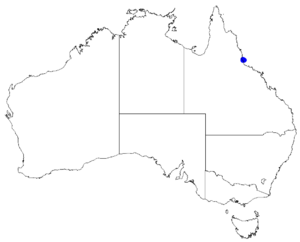Andy Jensz's boronia facts for kids
Quick facts for kids Andy Jensz's boronia |
|
|---|---|
| Scientific classification | |
 |
|
| Occurrence data from Australasian Virtual Herbarium |
Boronia jensziae, also known as Andy Jenss's boronia or Hinchinbrook boronia, is a special plant. It belongs to the citrus family called Rutaceae. You can only find this plant growing naturally on Hinchinbrook Island in Queensland, Australia. This plant is a type of shrub that stands upright and has many branches. It has simple leaves and pretty pink or white flowers. Each flower has four petals and usually grows by itself where a leaf meets the stem.
Contents
What Does Andy Jensz's Boronia Look Like?
Andy Jensz's boronia is an upright shrub. It has many branches covered with tiny, star-shaped hairs. This plant can grow up to 2 m (7 ft) tall.
Leaves and Flowers
The leaves are shaped like an oval, called elliptic. They are about 15–45 mm (0.6–2 in) long and 6–11.5 mm (0.2–0.5 in) wide. Each leaf has a small stalk, or petiole, about 2–4 mm (0.08–0.2 in) long.
The flowers are pink to white. They usually grow one by one where a leaf joins the stem, which is called a leaf axil. Sometimes, you might see up to three flowers together. Each flower sits on a small stalk called a pedicel, which is about 2–5 mm (0.08–0.2 in) long.
Flower Parts
Each flower has four sepals. Sepals are like small, leaf-like parts that protect the flower bud. These sepals are about 4 mm (0.16 in) long. The four petals are slightly hairy. They are about 5.5–7 mm (0.2–0.3 in) long and 3–3.5 mm (0.1–0.1 in) wide. The petals get bigger as the fruit starts to grow.
The flower also has eight stamens. Stamens are the parts that produce pollen. These stamens are hairy. Some stamens are longer than others.
When It Blooms and Fruits
Andy Jensz's boronia flowers from May to June. After flowering, it produces a fruit. The fruit is a smooth, hairless capsule. It is about 4–4.5 mm (0.16–0.18 in) long and 2–3.5 mm (0.079–0.14 in) wide.
How This Plant Got Its Name
Boronia jensziae was first officially described in 1999. A scientist named Marco F. Duretto wrote about it in a science journal called Austrobaileya.
The second part of its scientific name, jensziae, is a special way to honor someone. It was named after Andrea Susan Jensz. She helped the scientists who described the plant.
Where Does Andy Jensz's Boronia Live?
Andy Jensz's boronia grows in different types of places. You can find it in open forests and also in areas with low, shrubby plants called heath. It grows on the top of Mount Bowman. This plant is only found on Hinchinbrook Island.
Is Andy Jensz's Boronia Protected?
The Queensland Government lists Boronia jensziae as a plant of "least concern." This means it is not currently at high risk of disappearing. This protection is under the Nature Conservation Act 1992.

